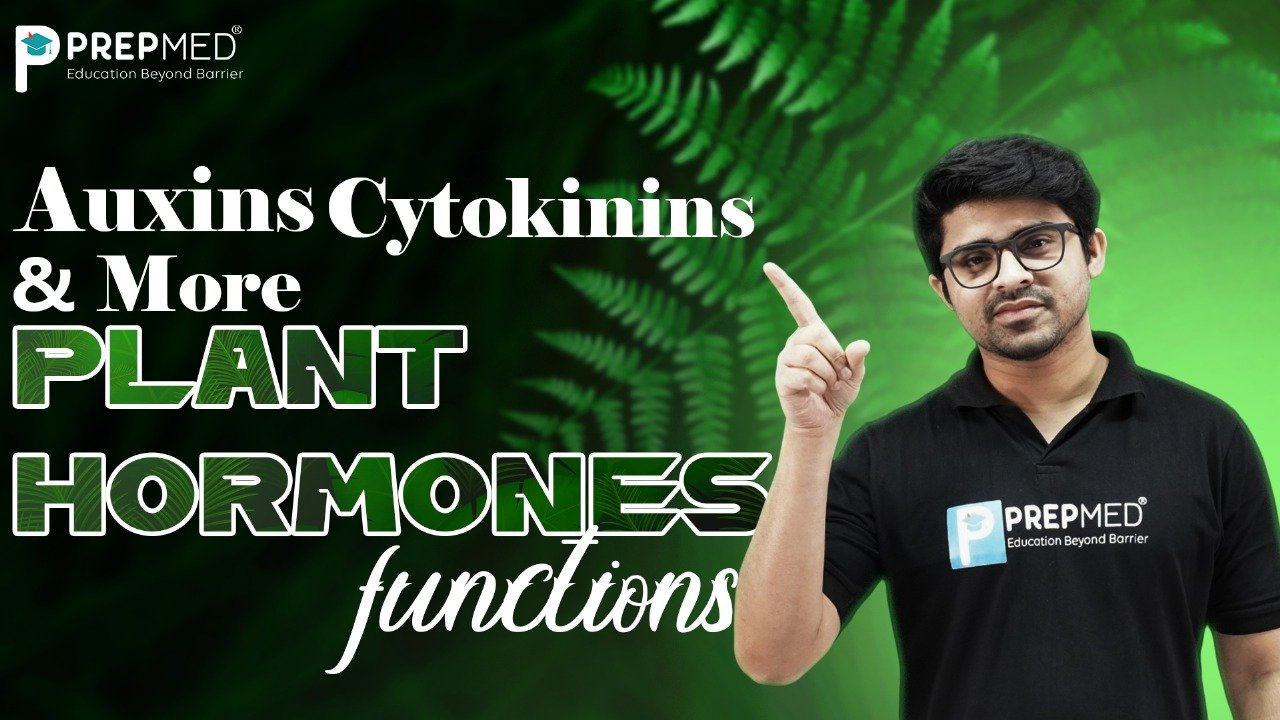April 14, 2025
Auxins, Cytokinins & More: Plant Hormones functions
Plant hormones function as essential chemical signals that govern various developmental processes, together with growth-related functions in plants. Hormones regulate key plant functions, which include cell division as well as elongation, differentiation, and environmental response abilities. Plant hormones differ from animal hormones because they originate from one section of the plant and transfer their effects across extensive distances to other plant regions.
Several plant growth hormones perform unique functions.
- Plant hormones like auxins help in cell elongation, and these hormones maintain essential developmental processes, including phototropism.
- Plants use cytokinins to initiate cell division, and these hormones also regulate the development of roots and shoots.
- Gibberellins enable seed germination and cause stems to extend in length.
- Another primary plant hormone, abscisic acid, regulates stress responses by controlling stomatal closure in drought conditions.
- Ethylene functions as a hormone that directs leaf abscission and regulates fruit maturation, as well as stress responses in plants.
The process of regulating plant growth and development occurs through complex mechanisms in which hormones form interconnected networks to control plant reactions to both internal signals and external factors. Knowledge of plant hormones leads to better crop yields and improved stress resistance and supports sustainable agricultural practices. The study of plant hormone signaling pathways and their interactions provides insights into how plants adapt to their environment and achieve optimal growth.
What do you understand by differentiation and dedifferentiation?
The cells produced from root apical and shoot-apical meristems and cambium differentiate before maturing to execute their specific functions. This process, leading to cell maturation, is known as differentiation. During the process of cell differentiation, the cells undergo various structural changes in the walls and protoplasm.
Plants show another interesting phenomenon. Living differentiated cells that have lost their capacity to divide can regain their ability to divide under specific conditions. The process is known as dedifferentiation.
Types of Plant Hormones and Their Functions

Plant hormones, also known as phytohormones, are chemicals that regulate various aspects of plant growth, development, and responses to environmental stimuli. The main types of plant hormones, along with their functions:
Auxins:
The primary functions of auxins include cell elongation as well as root initiation and growth direction. These plant hormones drive fundamental plant functions, including phototropism (directional growth due to light) and gravitropism (how plants grow because of gravity). The development of flowers alongside fruits and leaves depends on auxins.
Auxins also enhance the process of flowering in pineapples. Auxins in plants prevent fruit and leaf drop at early stages but enhance abscission of older mature leaves and fruits. Auxins also induce parthenocarpy and control xylem differentiation.
Auxins like IAA and indole butyric acid (IBA) have been isolated from plants. Synthetic Auxins are NAA (naphthalene acetic acid) and 2, 4-D (2, 4-dichlorophenoxyacetic).
Cytokinins:
The function of cytokinin hormones includes promoting cell division and directing lateral bud development while initiating new shoots and regulating leaf aging. Plants use auxins together with cytokinins to manage their growth process, specifically during the formation of new tissues.
Cytokinin hormone helps in the production of new leaves and chloroplasts in leaves, enhances the growth of the lateral shoot, and forms adventitious shoots. Cytokinins also help to overcome the process of apical dominance.
Gibberellins:
Gibberellins activate the growth of stems along with seed development and the process of flowering. Gibberellins play a vital role in breaking seed dormancy, and they improve fruit development. In some plant species, Gibberellins cause plants to grow higher and develop larger fruits.
Gibberellins lead elongation of fruits like apples while simultaneously enhancing their shape. They also delay senescence. Gibberellins enhance bolting behavior (pre-flowering internode growth) in beet and cabbage, together with plants exhibiting a rosette growth pattern.
Abscisic Acid (ABA):
The stress hormone abscisic acid helps plants respond to unfavorable conditions by allowing them to adapt to drought or cold. The abscisic acid hormone regulates stomata to reduce water loss while ensuring seed dormancy and stopping seed germination until ideal conditions become available.
ABA functions as a metabolic inhibitor while also slowing down overall plant growth. ABA inhibits seed germination. ABA leads to stoma closure in plants while simultaneously enhancing their ability to withstand different types of stress. This hormone is also known as the stress hormone. The hormone ABA serves critical functions during seed developmental stages as well as maturation and dormancy processes.
Ethylene:
The gaseous hormone ethylene controls three fundamental processes in plants, including fruit ripening together with leaf abscission, and response to environmental stress. Plants use this hormone to control aging, which results in the sequence of events that include fruit ripening along with flower fading and leaf drop. Plants deploy ethylene as a defense hormone to protect themselves against pathogens.
The effects of ethylene on plants result in horizontal growth in seedlings and axis swelling, in addition to forming apical hooks in dicotyledonous seedlings. The plant hormone ethylene promotes senescence while triggering abscission in various organs, including leaves and flowers.
Ethylene functions effectively as a ripening agent for fruits. Etiene accelerates the respiratory rate that occurs when fruits mature. The phenomenon of increasing respiration rate, which occurs during ripening, is known as respiratory climactic. Ethylene functions to eliminate seed and bud dormancy. Ethylene functions to activate peanut seed germination and potato tuber sprouting.
The application of ethylene accelerates deep water rice plants to expand their petioles and internodes rapidly. The process keeps leaves and upper shoot sections above the water surface. Through root growth promotion and root hair development, ethylene enables plants to extend their absorption surface.
The most widely used compound as a source of ethylene is ethephon. The use of ethephon speeds up tomato and apple fruit ripening, along with accelerating abscission in flowers and fruits (thinning of cotton, cherry, walnut). It promotes female flowers in cucumbers, thereby increasing the yield.
Conclusion:
Plant hormones like Auxins, Cytokinins, and others play crucial roles in regulating growth, development, and response to environmental stimuli. Auxins primarily influence cell elongation and root formation, while Cytokinins promote cell division and shoot growth. Together, they maintain a balance that governs processes such as flowering, fruit development, and stress response.
Hormonal interactions, like those between Auxins and Cytokinins, ensure that plants grow and adapt efficiently to their environment. Understanding these hormones' functions enhances our ability to improve agricultural practices and boost crop productivity, ultimately contributing to global food security.
FAQs for Plant Hormones:
1. What are Auxins in plants?
Auxins are plant hormones that regulate various processes, including cell elongation, root development, and responses to light and gravity. They play a vital role in plant growth and help in the formation of new tissues.
2. How do Cytokinins affect plant growth?
Cytokinins stimulate cell division and promote the growth of shoots and leaves. They also delay aging in plant tissues and work in conjunction with Auxins to regulate growth and development.
3. What is the role of plant hormones in stress response?
Plant hormones, such as Abscisic Acid (ABA), play key roles in stress responses, including drought and high salinity. They help plants adapt by closing stomata, reducing water loss, and triggering protective mechanisms.






